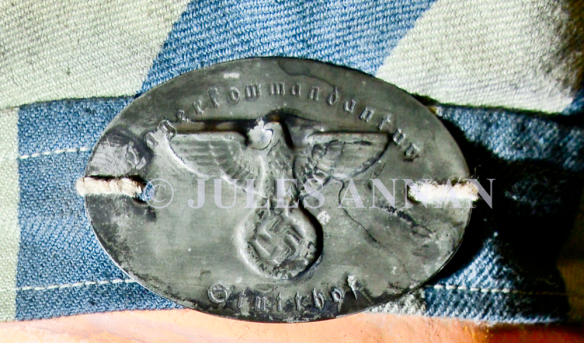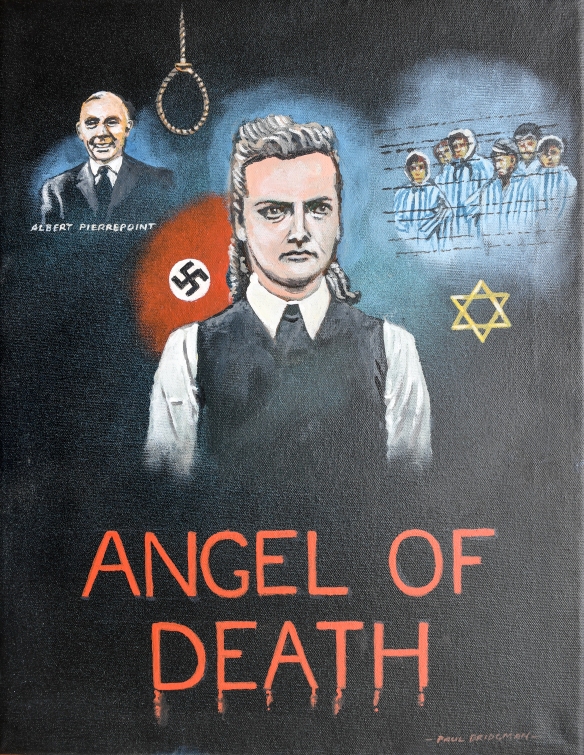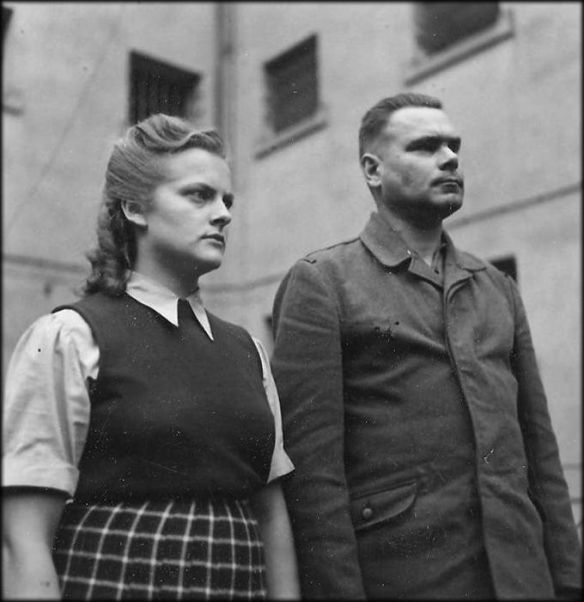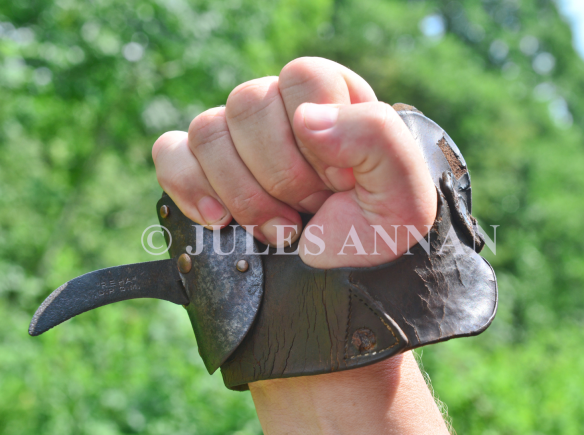Here below is a very brief look and insight into our Nazi Holocaust Years Exhibition here at The Crime Through Time Collection , Littledean Jail, UK


Original painting by Gloucestershire artist Paul Bridgman of Adolf Hitler here on display at The Crime Through Time Collection , Littledean Jail , UK .

ABOVE : Original handwritten, inscribed and signed Adolf Hitler photo dated 9 November 1943 here on display at the Jail .

HERE IS A PICTURE OF SOME OF THE EMPTY ZYKLON B CANISTERS USED AT VARIOUS NAZI DEATH CAMP GAS CHAMBERS , AS CAN BE SEEN HERE ON DISPLAY . ( LEST WE FORGET )
POLITE WARNING … THE CRIME THROUGH TIME COLLECTION AT LITTLEDEAN JAIL (WHERE UPON THIS EXHIBITION IS HOUSED ) IS NOT SUITABLE FOR CHILDREN OR THOSE OF YOU WHO ARE EASILY OFFENDED , DISTURBED OR OF A SENSITIVE NATURE


Original painting by Gloucestershire artist Paul Bridgman on display at The Crime Through Time Collection, Littledean Jail ,UK.
THE CONTENT HERE ON DISPLAY BOTH ONLINE AND WITHIN THE JAIL IS IN THE MAIN HARD HITTING , GRAPHIC, EXPLICIT , IN YOUR FACE , TONGUE IN CHEEK , CONTROVERSIAL AND TO MANY … VERY DISTURBING .

WITH THIS IN MIND AND FOR YOUR BENEFIT AND COMFORT … PLEASE DO TAKE A LOOK AT SOME OF OUR FACEBOOK POSTS , READ OUR TOURISM LEAFLETS AND DO TAKE NOTICE OF ALL OUR WARNING SIGNAGE PRIOR TO ENTERING THE JAIL .



Above : Original painting by Gloucestershire Artist Paul Bridgman on display here at Littledean Jail, of the sadistic Irma Grese …. deemed to be “The Angel of Death ” , who was subsequently arrested and later hanged by British Hangman Albert Pierrepoint
Irma Ida Ilse Grese (7 October 1923 – 13 December 1945) was a female SS guard at the Nazi concentration camps of Ravensbrück and Auschwitz, and served as warden of the women’s section of Bergen-Belsen.

Grese was convicted for crimes against humanity committed at Auschwitz and Bergen-Belsen, and sentenced to death at the Belsen trial. Executed at 22 years of age, Grese was the youngest woman to die judicially under British law in the 20th century. She was nicknamed by the camps’ inmates “the Hyena of Auschwitz  Above : Original painting by Gloucestershire Artist Paul Bridgman on display here at Littledean Jail, of the sadistic Irma Grese ….
Above : Original painting by Gloucestershire Artist Paul Bridgman on display here at Littledean Jail, of the sadistic Irma Grese …. 
Josef Kramer (10 November 1906 – 13 December 1945) was the Commandant of the Bergen-Belsen concentration camp. Dubbed The Beast of Belsen by camp inmates, he was a notorious German Nazi war criminal, directly responsible for the deaths of thousands of people. He was detained by the British army after the Second World War, convicted of war crimes and hanged on the gallows in Hamelin prison by British executioner Albert Pierrepoint.

Above : Original oil painting by Gloucestershire Artist Paul Bridgman of Josef Kramer , The Beast of Belsen , on display here at Littledean Jail,
 Below: Original painting by Gloucestershire Artist Paul Bridgman on display here at Littledean Jail, of the evil and sadistic Josef Kramer …. better known as “The Beast of Belsen “
Below: Original painting by Gloucestershire Artist Paul Bridgman on display here at Littledean Jail, of the evil and sadistic Josef Kramer …. better known as “The Beast of Belsen “
Used original Zyklon B 100gram sized canisters from one of the first Nazi gas chambers situated at Grafeneck Euthanasia Center, housed in Grafeneck Castle, Germany . It had officially opened in January 1940 and was closed on the orders of Nazi warlord Himmler in December 1940 . This facility was mainly used to exterminate mentally Handicapped and retarded victims as part of the Nazi euthanasia program. These canisters are exceptionally rare find from what was one of the earliest gas chambers and crematorium facilities . There is evidence that exists to the effect that a minimum 10, 654 were gassed there, though inevitably many more victims were murdered there before its closure . these canisters are now on public display at the Crime Through Time Collection, Littledean Jail
Here is some more interactive, historical and hopefully educational background footage and insight into the horrors of the Nazi Holocaust years. The photo gallery below the first video also provides a brief pictorial glimpse into our own disturbing Nazi Holocaust exhibition here at the jail .
We also feature a great many interactive pieces in relation to UK World War 2 Special Forces, including the SOE (Special Operations Executive) and the SAS (Special Air Service) …. whom were both actively involved in a great many operations against the Nazi’s during this period .

Original painting by Gloucestershire artist Paul Bridgman on display at The Crime Through Time Collection, Littledean Jail , UK
BELOW IS A BRIEF PICTORIAL GLIMPSE INTO SOME OF THE EXHIBIT ITEMS HERE ON DISPLAY AT LITTLEDEAN JAILS NAZI HOLOCAUST EXHIBITION .
- Srbosjek (literally “Serb cutter” in Croatian and Serbian, often referred to as “cutthroat”) is the colloquial serbo-Croatian term for a type of knife used for killing …
- Witness drawing of the sboskek wrist knife used to quickly dispatch prisoners at Jasenovac
- Srbosjek (literally “Serb cutter” in Croatian and Serbian, often referred to as “cutthroat”) is the colloquial serbo-Croatian term for a type of knife used for killing …
The Holocaust was the systematic, bureaucratic, state-sponsored persecution and murder of approximately six million Jews by the Nazi regime and its collaborators. “Holocaust” is a word of Greek origin meaning “sacrifice by fire.” The Nazis, who came to power in Germany in January 1933, believed that Germans were “racially superior” and that the Jews, deemed “inferior,” were an alien threat to the so-called German racial community.
During the era of the Holocaust, German authorities also targeted other groups because of their perceived “racial inferiority”: Roma (Gypsies), the disabled, and some of the Slavic peoples (Poles, Russians, and others). Other groups were persecuted on political, ideological, and behavioral grounds, among them Communists, Socialists, Jehovah’s Witnesses, and homosexuals.
WHAT WAS THE HOLOCAUST?
In 1933, the Jewish population of Europestood at over nine million. Most European Jews lived in countries that Nazi Germany would occupy or influence during World War II. By 1945, the Germans and theircollaborators killed nearly two out of every three European Jews as part of the “Final Solution,” the Nazi policy to murder the Jews of Europe. Although Jews, whom the Nazis deemed a priority danger to Germany, were the primary victims of Nazi racism, other victims included some 200,000 Roma (Gypsies). At least 200,000 mentally or physically disabled patients, mainly Germans, living in institutional settings, were murdered in the so-called Euthanasia Program.
As Nazi tyranny spread across Europe, the Germans and their collaborators persecuted and murdered millions of other people. Between two and three million Soviet prisoners of warwere murdered or died of starvation, disease, neglect, or maltreatment. The Germans targeted the non-Jewish Polish intelligentsia for killing, and deported millions of Polish and Soviet civilians for forced labor in Germany or in occupiedPoland, where these individuals worked and often died under deplorable conditions. From the earliest years of the Nazi regime, German authorities persecuted homosexuals and others whose behavior did not match prescribed social norms. German police officials targeted thousands of political opponents (including Communists, Socialists, and trade unionists) and religious dissidents (such as Jehovah’s Witnesses). Many of these individuals died as a result of incarceration and maltreatment.
ADMINISTRATION OF THE “FINAL SOLUTION”
In the early years of the Nazi regime, the National Socialist government established concentration camps to detain real and imagined political and ideological opponents. Increasingly in the years before the outbreak of war, SS and police officials incarcerated Jews, Roma, and other victims of ethnic and racial hatred in these camps. To concentrate and monitor the Jewish population as well as to facilitate later deportation of the Jews, the Germans and their collaborators created ghettos, transit camps, and forced-labor camps for Jews during the war years. The German authorities also established numerous forced-labor camps, both in the so-called Greater German Reich and in German-occupied territory, for non-Jews whose labor the Germans sought to exploit.
Following the invasion of the Soviet Union in June 1941,Einsatzgruppen (mobile killing units) and, later, militarized battalions of Order Police officials, moved behind German lines to carry out mass-murder operations against Jews, Roma, and Soviet state and Communist Party officials. German SS and police units, supported by units of the Wehrmacht and the Waffen SS, murdered more than a million Jewish men, women, and children, and hundreds of thousands of others. Between 1941 and 1944, Nazi German authorities deported millions of Jews from Germany, from occupied territories, and from the countries of many of its Axis allies to ghettos and to killing centers, often called extermination camps, where they were murdered in specially developed gassing facilities.
THE END OF THE HOLOCAUST
In the final months of the war, SS guards moved camp inmates by train or on forced marches, often called “death marches,” in an attempt to prevent the Allied liberation of large numbers of prisoners. As Allied forces moved across Europe in a series of offensives against Germany, they began to encounter andliberate concentration camp prisoners, as well as prisoners en route by forced march from one camp to another. The marches continued until May 7, 1945, the day the German armed forces surrendered unconditionally to the Allies. For the western Allies, World War II officially ended in Europe on the next day, May 8 (V-E Day), while Soviet forces announced their “Victory Day” on May 9, 1945.
In the aftermath of the Holocaust, many of the survivors found shelter in displaced persons (DP) camps administered by the Allied powers. Between 1948 and 1951, almost 700,000 Jews emigrated to Israel, including 136,000 Jewish displaced persons from Europe. Other Jewish DPs emigrated to the United States and other nations. The last DP camp closed in 1957. The crimes committed during the Holocaust devastated most European Jewish communities and eliminated hundreds of Jewish communities in occupied eastern Europe entirely








































































































































































































